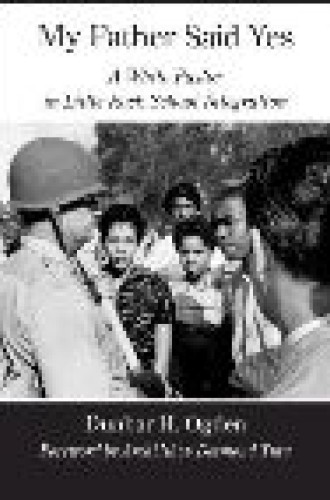My Father Said Yes: A White Pastor in Little Rock School Integration
On September 4, 1957, nine African-American students walked through a seething mob to the front of Central High in Little Rock, Arkansas, to enroll in school. They were turned away by the National Guard, which had been called out by Arkansas governor Orval Faubus. “Blood will run in the streets,” said Faubus, “if Negro pupils should attempt to enter Central High School.” The man who led the nine to the lines of the National Guard on that fateful morning was a white pastor named Dunbar Ogden Jr.
His son, Dunbar H. Ogden, professor emeritus of dramatic art at the Univer sity of California, has collected his father’s writings and has spent hours interviewing him. This book tells the wrenching story of a very courageous man who dealt with his own private demons while combating racism in both the school system and his church. The pastor of Central Presbyterian Church in Little Rock, Ogden was a fixer, a man of action. But he was plagued by clinical depression. Prior to coming to Little Rock, he had been hospitalized twice and forced to resign some prestigious pulpits. Still, his intellect, his deep faith in God’s providence (a word he used often) and his leadership skills equipped him for the role he played during the school crisis.
On the night before the carefully selected nine students were to enroll, Ogden received a call from Daisy Bates, the president of the Arkansas chapter of the NAACP and co-owner of the town’s black newspaper. She called to ask his help in escorting the students because he was president of the local ministerial association. “Well now, Mrs. Bates,” he said. “Do you think this is the business of the church? Do you think it’s part of the work of religion to participate in a movement that might be thought of as more political and social than of a churchly nature?”
Bates stood firm. So Ogden called his fellow clergy and learned that only one other pastor would brave the potentially violent crowd. “If I go out there tomorrow morning,” the word came back again and again, “it will split apart my congregation and destroy my effectiveness.” Ogden prayed and perspired throughout the long night. He did not know what he was going to do. A man of action, he hated indecision.
When he met Bates and the nine students the next morning, he was still wavering. A black man approached him and said, “Reverend Ogden, isn’t it about time you made up your mind?” Ogden “had the really strange feeling, as clear as day . . . This is right; this is what I should do.” In that moment he made a choice that would change his life and help change the course of history.
The consequences of his decision to lead the nine were both predictable and tragic. Worship attendance in Ogden’s congregation declined from 200 that fall to 80 by the next spring. Influential church members called every fellow member and asked them to abstain from attending church and to cancel their pledges. Secret meetings were held to fashion a written proposal to circumvent Presbyterian polity and squeeze Ogden out.
Daisy Bates and her husband, L. C. Bates, were overwhelmed by the apathy of the black community, and the advertising revenue of their newspaper, the State Press, dried up. The pressure from the white oligarchy that controlled the economic and political life of Little Rock drove them to close the paper after 19 years of uninterrupted operation.
While 1,000 federal troops and 85 rotating, federalized National Guard members kept the peace, an interfaith day of prayer was called on October 12, 1957, when the crisis was at its worst. Two journalists, Ernest Campbell and Thomas Pettigrew, had come to town to do research for a book on the Little Rock clergy in the crisis. Their conclusion was devastating: “Clergy and congregations exerted no influence on the course of integration. With rare exceptions, impact on integration could be brought to bear only through nonchurch organizations.” After the day of prayer, the younger Ogden declares, “most of the ministerial participants ceased their integrationist activity completely. . . . Not only did the Day of Prayer prove ineffective in the cause of peace, but much more seriously it siphoned off what potential there was for effective church action.”
The victorious truth of the elder Ogden’s brave story is that not only did he make a prophetic witness on the day school opened but he stood with the nine through the entire school year when they were vilified, spat on, demeaned and mistreated. He marched with them and matched their courage.





